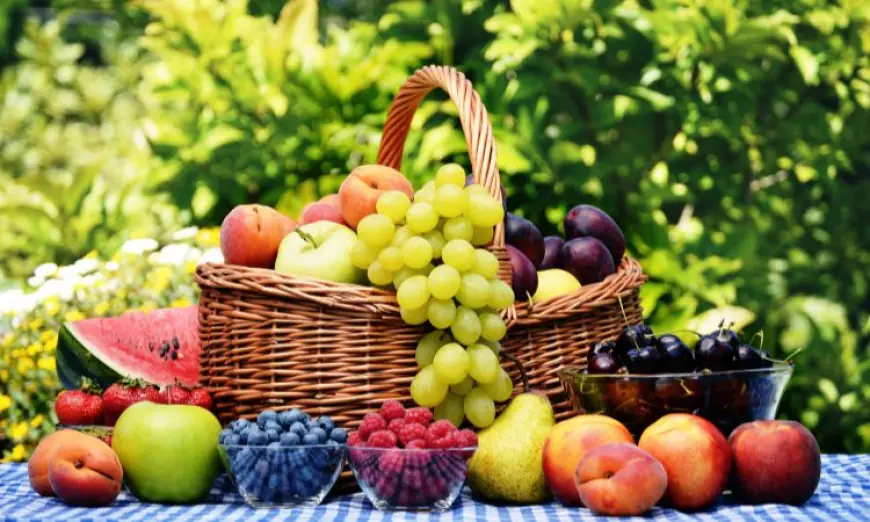Global Fruits Market Share, Size & Analysis | 2025-2033
The global fruits market, valued at USD 596.49 billion in 2024, is projected to grow at a CAGR of 3.50% to reach USD 812.95 billion by 2033. Key growth drivers include increasing health consciousness, urbanization, and rising disposable incomes, along with advancements in storage and packaging. Challenges such as perishability, seasonal availability, and high costs of organic farming persist. Trends like organic fruit farming, innovative packaging, and the rise of superfruits are reshaping the market. North America, Europe, and Asia-Pacific lead in consumption and production, with significant export contributions from Latin America. Key players include Dole Food, Del Monte, and Sunkist. Opportunities lie in emerging markets, product innovation, and e-commerce expansion, while addressing supply chain and climate challenges remains crucial for sustained growth.

The global Fruits Market Size, valued at approximately USD 596.49 billion in 2024, is poised for significant growth, with projections estimating a market value of USD 812.95 billion by 2033. This steady expansion, driven by a CAGR of 3.50% during the forecast period of 2025-2033, reflects rising consumer preferences for healthy and natural food products, growing awareness of the benefits of fruits, and increased demand from various industries, including food processing and cosmetics.
Key Benefits
-
Nutritional Value: Fruits are a rich source of essential vitamins, minerals, and dietary fiber, promoting overall health and reducing the risk of chronic diseases such as cardiovascular ailments and diabetes.
-
Economic Impact: The fruits market contributes significantly to the agricultural economy, supporting millions of farmers and stakeholders across the globe.
-
Versatility in Use: Beyond direct consumption, fruits are used in juices, desserts, bakery products, cosmetics, and pharmaceuticals, making them a crucial component of various industries.
-
Sustainability: Growing fruits, especially through organic and eco-friendly practices, supports sustainable agriculture and environmental conservation.
Key Industry Developments
-
Technological Advancements: Innovations in fruit cultivation, storage, and transportation have enhanced product quality and shelf life.
-
Expansion of E-commerce: Online platforms are revolutionizing the way fruits are sold, providing convenience and accessibility for consumers.
-
Government Initiatives: Policies supporting organic farming, subsidies for fruit cultivation, and export incentives are boosting market growth.
-
Emergence of Functional Foods: The rise of health-conscious consumers has led to increased demand for functional foods, further driving fruit consumption.
Driving Factors
-
Health and Wellness Trends: Growing awareness about the importance of a balanced diet has led to higher fruit consumption.
-
Urbanization and Changing Lifestyles: Rapid urbanization is encouraging the consumption of convenient, ready-to-eat fruit products.
-
Rising Disposable Income: Higher spending capacity, especially in developing countries, has fueled the demand for premium and exotic fruits.
-
Technological Innovations: Advanced storage and packaging solutions are reducing post-harvest losses, ensuring a steady supply.
-
Export Growth: Increasing global trade and demand for exotic fruits are opening new opportunities for producers.
Restraining Factors
-
Seasonal Nature: Many fruits are seasonal, leading to fluctuating supply and prices.
-
High Perishability: Fruits’ short shelf life poses challenges in storage and logistics.
-
Market Volatility: Dependence on weather conditions and vulnerability to pests can affect yield and market stability.
-
Cost of Organic Production: Although in demand, organic fruits have higher production costs, limiting their affordability.
Market Segmentation
-
By Type:
-
Citrus Fruits
-
Berries
-
Tropical Fruits
-
Pomes (apples, pears)
-
Stone Fruits (peaches, cherries)
-
Others
-
-
By Application:
-
Direct Consumption
-
Food Processing
-
Beverages
-
Cosmetics
-
Pharmaceuticals
-
-
By Distribution Channel:
-
Supermarkets and Hypermarkets
-
Online Retail
-
Specialty Stores
-
Others
-
-
By Region:
-
North America
-
Europe
-
Asia-Pacific
-
Latin America
-
Middle East & Africa
-
Market Outlook
The fruits market is set to witness consistent growth due to increasing health consciousness, government initiatives supporting agriculture, and technological advancements in farming and supply chain management. The rise of organic and exotic fruit varieties, coupled with innovative marketing strategies, will play a pivotal role in shaping the future of the industry.
Market Overview
-
Consumer Trends: Rising demand for fresh, organic, and minimally processed fruits.
-
Economic Contribution: The fruits market forms a substantial part of the global agriculture sector, driving employment and trade.
-
Supply Chain: Improved cold chain logistics and storage facilities are addressing key challenges in fruit perishability.
Trends
-
Organic Farming: Increasing consumer preference for pesticide-free and non-GMO fruits.
-
Superfruits: Fruits like acai berries, dragon fruits, and kiwis are gaining traction due to their high nutritional content.
-
Innovative Packaging: Eco-friendly and biodegradable packaging solutions are enhancing market appeal.
-
Digital Transformation: Online retail channels are growing rapidly, with platforms offering home delivery of fresh fruit
Regional Analysis/Insights
-
North America: The region has a well-established fruits market, driven by high demand for organic and exotic fruits.
-
Europe: The focus on sustainability and organic farming practices is fueling growth.
-
Asia-Pacific: Home to diverse fruit production, the region is experiencing increased exports and domestic consumption due to rising incomes and urbanization.
-
Latin America: A significant exporter of tropical fruits, supported by favorable climatic conditions.
-
Middle East & Africa: Growing adoption of modern farming techniques and rising imports are boosting the market.
Analysis
-
Economic Factors: Economic growth in emerging countries is increasing fruit consumption and trade.
-
Technological Impact: Precision agriculture and advanced logistics are improving efficiency and reducing waste.
-
Consumer Behavior: Shifts toward healthier eating habits and demand for convenience are reshaping the market landscape.
Top Impacting Factors
-
Rising health awareness.
-
Increased urbanization.
-
Government support for sustainable agriculture.
-
Growth in online retail.
-
Innovations in packaging and storage.
Target Audience
-
Health-conscious consumers.
-
Food and beverage manufacturers.
-
Retailers and wholesalers.
-
Exporters and importers.
-
Agricultural stakeholders.
Major Key Players
- Dole Food Company Inc.
- Del Monte Foods Inc.
- Chiquita Brands International Sàrl
- Greenyard NV
- Sunwest Fruit Company
- Others
Opportunities
-
Organic Farming: Increasing demand for eco-friendly and sustainable fruit production methods.
-
Emerging Markets: Untapped potential in regions like Africa and South America.
-
Product Innovation: Development of functional and fortified fruit products.
-
Digital Channels: Growth of e-commerce platforms for direct-to-consumer sales.
Challenges
-
Supply Chain Management: Maintaining freshness during transit.
-
Climate Change: Adverse weather conditions affecting crop yield.
-
Market Competition: Intense competition among producers and retailers.
-
Regulatory Compliance: Stringent food safety and quality standards.
Scope
The fruits market holds vast potential for growth, driven by increasing global demand for healthy and natural food products. Opportunities lie in the development of innovative fruit-based products, sustainable farming practices, and the expansion of digital sales channels. Additionally, collaboration between governments, producers, and technology providers can address current challenges and unlock new possibilities.
The global fruits market’s journey toward achieving sustainable growth will depend on the adoption of modern agricultural techniques, technological integration, and consumer awareness initiatives, creating a resilient and thriving ecosystem for all stakeholders.
What's Your Reaction?
 Like
0
Like
0
 Dislike
0
Dislike
0
 Love
0
Love
0
 Funny
0
Funny
0
 Angry
0
Angry
0
 Sad
0
Sad
0
 Wow
0
Wow
0


















































